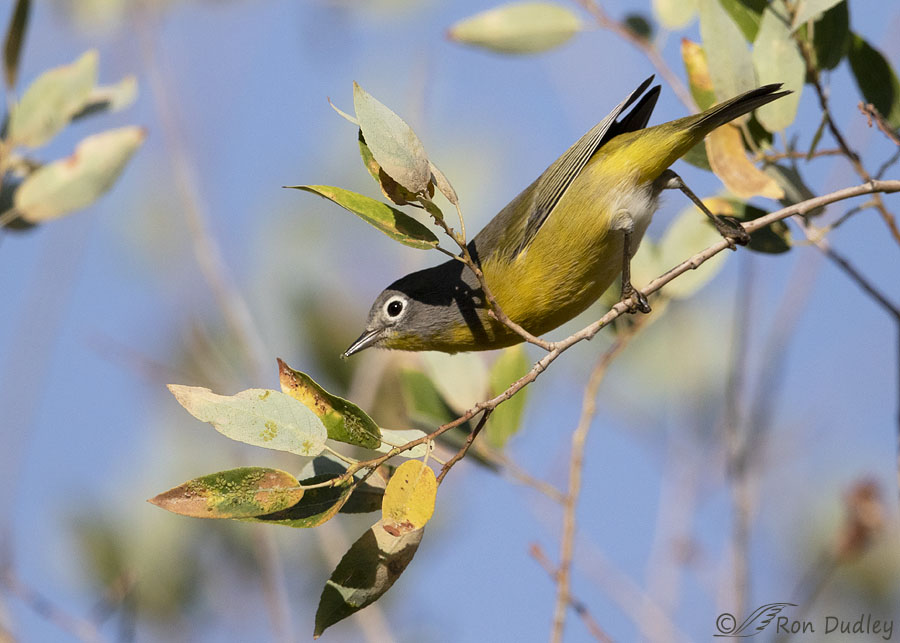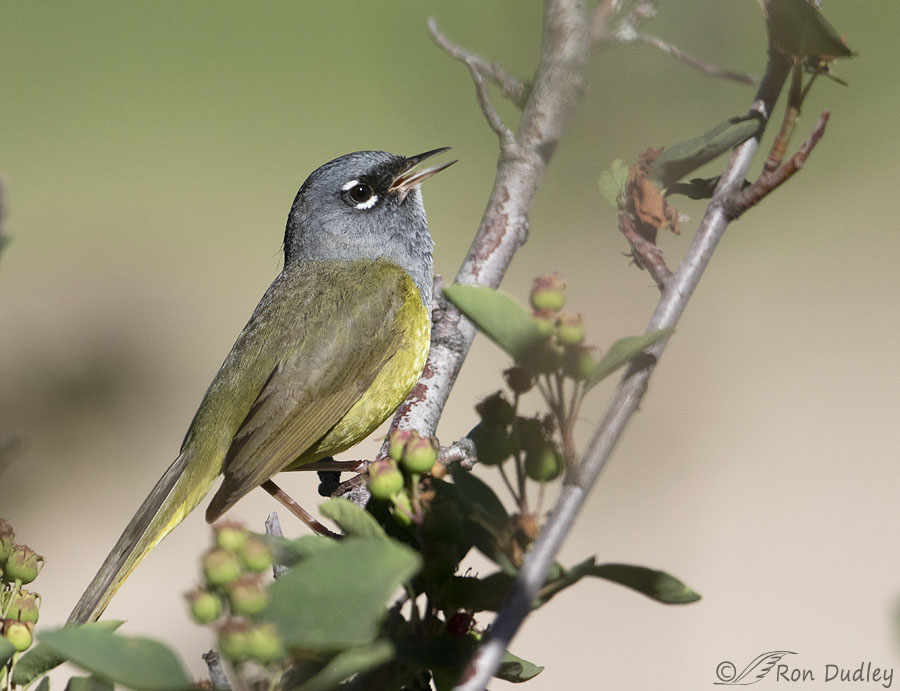Trying to make lemonade out of an unusually sour lemon.
In yesterday’s post I mistakenly identified a Nashville Warbler as a MacGillivray’s Warbler. I realized my error only minutes after publishing my post and even though I immediately added a note to the post acknowledging my mistake the damage was done. Making such a basic blunder is one of my biggest fears about blogging and bird ID isn’t my strongest point so I always try to be extra careful in that regard. But yesterday one slipped through the cracks.
In a comment on that post bird authority Dan Gleason tried to make me feel a little better about my error with the following comment:
- “Nashville and MacGillivray’s Warblers are easily confused, especially as people are learning to ID their birds. By making this mistake and pointing out the complete, not broken eye ring of the Nashville, you’ve called attention to this feature and provided a good aid, along with a great photo, to help others to distinguish these two species when they see them in the future. Mistakes can always be a helpful tool in learning.”
So today I decided to do the best job I could of turning a serious error made in a public forum into a more effective ‘learning tool.” The easiest way to distinguish between Nashville and MacGillivray’s Warblers is using the difference in their eye rings as a field mark. Yesterday I briefly described that difference but didn’t include photos of both species actually showing the difference..
Since most of us learn best visually I’ll do that today.

This a different photo of the male Nashville Warbler I posted yesterday (initially I had mistakenly called him a female MacGillivray’s Warbler). Notice the bold white eye ring that completely encircles the eye. Males and females are similarly (though not exactly) colored and both sexes have the complete white eye ring.

This is a male MacGillivray’s Warbler. Males of this species have black lores (between the eye and the base of the bill) but the female lacks the black lores and both sexes can be confused with Nashville Warblers. Even Sibley says the two species are “often confused”.
But notice that the eye ring of MacGillivray’s Warblers is ‘broken’ or incomplete, to the point that the whites surrounding the eyes are often called “eye crescents” instead of eye rings. There are other more subtle differences between the two species but the eye ring difference is the most distinctive and I think the best field mark.
I should have noticed that difference in yesterday’s post but I… just… didn’t. Hopefully today’s post will help all of us to better distinguish the two species.
We all make mistakes but if I make the same mistake again just shoot me.
Ron


Fantastic shots Ron1 thanks for sharing!
Thanks, Charlotte.
You are too hard on yourself. I like how it became educational for us all.
“I like how it became educational for us all”
The lemonade…
Thank you. I am glad for this lesson, as I so often am (despite knowing that I will never be tested in the field).
And if only the mistakes I made were as understandable as that one of yours yesterday.
I know what you mean, EC. I make some pretty off the wall mistakes too. Where did THAT one come from…
I know it means so much more to some birders than others and I know that there are many really good reasons to know the “correct” names of the birds we encounter but when it comes right down to it…the little birds could care less what humans call them. That we appreciate them and the intricacies of their lives in the moment is the really important bit for me. If I can’t find their names in the book or on the screen did I at least notice all that they were up to while I was in their presence? What was lost in the time I missed looking away to find a name?
And I’d argue that–correctly IDed every time…or not–it is the quality of your photos that is the biggest deal. I can easily forgive the occasional mistaken identity. Because the detail your images always provide permits those of us less skilled to see and appreciate–from those great views implanted in our mind’s eyes by your photos–that that LBJ has a complicated and grand life full of daily drudgery and wonder…just like ours.
You made several excellent points, Jim. Thank you.
You weren’t wrong. You were just testing us to see if we were paying attention. I used to do that in my classroom all the time.
And regardless of ID, both of these birds are well-represented through your lens!
Ha, I used to do it in the classroom too, Marty. Not this time I’m afraid…
“The eyes have it” — that use of a whole lot of eyeliner by the Nashville is (now) unforgettable. Thanks for the photo comparison. Now I hope to get lucky enough to see both on a birding adventure one of these days.
As a retired newsletter editor, I tended to dwell overly much on published errors long after they’d been forgiven by others, but eventually came to realize that as long as no real damage was done (other than to my own pride), I just needed to learn and let go. The biggest lesson: “misteaks” happen!
Chris, on one level I know my mistake is really no big deal. On the other hand my blog is about birds and I’m ‘supposed’ to know my subjects. I’m over it now but it took a while…
Great photos illustrate this feature well. The full dark throat of the male MacGillivray’s is also distinctive. But my students sometimes had difficulty remembering which species had a complete eyering and which was incomplete. Sometimes silly tricks can help. So many years ago one student suggested that MacGillivray’s is a two part name (The M and the G start each part), therefore, the two part ring must be MacGillivray’s. If tricks like this work, I’m all for them.
They do work and that one works, Dan. I used to tell my students about tricks like that. Lots of them. Here’s an example that comes to mind.
In zoology when we were studying gastropods (snails and such) I taught them about sinistral and dextral shells. Sinistral shells have a left handed (counter clockwise) direction of coiling and dextral shells have a right handed direction of coiling. My students had a very difficult time remembering which was which.
So I’d tell them my ex-wife was left handed and she was “sinister”.
Problem solved. They nearly always remembered it correctly after that. And my ex-wife turned out to be useful after all…
Wow – good post Ron and appreciate learning the difference although it would be a long shot for me to see either here. Both can be seen in our area at appropriate times, but I have never seen either. Possibly they are not commonly seen in the areas where I take most of my photos.
Could be, Everett. Nashville Warblers are ‘uncommon migrants’ around here.
I would simply be ecstatic to see either one of these beautiful warblers!
It’s difficult to empathize with you, Ron, since I have never made a mistake. Ever. Really.
Great tutorial. Great photographs.
I envy you your infallibility, Wally! Thank you.
Thanks for the lesson. Like Judy, I’m likely to make that mistake myself… if I even recognize the two likely choices. Now I know why people say, “I’ve forgotten more than other people will ever learn.” The other people not having learned as much probably doesn’t apply to me, but the idea that I’m forgetting a lot certainly does! Oldsters have to be easy on ourselves.
“Oldsters have to be easy on ourselves”
In my case, point well taken, Nancy.
When my mistakes are corrected they are memorable opportunities for improvement. I will never forget when I was a little kid and very proud of my knowledge of natural history. I was pointing out to one of my friends how the “horns” of a deer in a photo were covered in velvet. He corrected me and I must have gone way down in his appreciation of my wisdom. More recently, my little granddaughter took me down again when I pointed out a “seagull.” She said, Grandpa, they are gulls. There is no such thing as a seagull!”
I think I’d love your granddaughter, Kenneth!
Ron took a photo,
MacGillivray’s? No.
Realizing the faux pas,
He came back to show,
How the Nashville does differ,
And now we all know.
He’s taught us a lesson,
We should not be surprised,
He’s a teacher and thus,
Has helped open our eyes.
A lesson he learned from his mother
Was to try to not make another.
“Show me” works MUCH better than “tell me” in my case. That being said I may still forget which is which…… Lovely photo’s and great lesson!
Lovely photo’s and great lesson! 
Yes, anyone can forget, Judy. I’m a prime example. But seeing it visually usually makes forgetting less likely.
Thanks for the lesson and the great photos!
You’re very welcome, Joanne.
Who wants to shoot a person who not only admits his mistakes but does everything to rectify them. Not me.
Thank you for another great lesson.
Thanks for the reprieve, Jorge!
Hi Ron. One more tip. MacGillvray is fully hooded all the way down to the chest. Nashville has yellow throat. It is the first thing I look for.
Thanks for the tip, Leslie.
Well heck! The difference, while there, is really pretty slight. And given that the molt is happening, that was an EASY mistake.
But the good thing about mistakes is that assuming they’re not lethal, is that we can learn from them and move on. DELIGHTED that “preparing this post has already had a cathartic effect and helped me get over it.”
Bottom line, YOU ROCK!
Thanks, Laura. That “assuming they’re not lethal” part is a biggie, isn’t it. Puts my mistake into perspective.
Puts my mistake into perspective.
We have all made an incorrect ID. A picture is worth a thousand words and your two pictures tells it all. Most of us are visual learners so your readers will certainly not make this error with the difference now imprinted on our memory! Thank you for that.
Kathy, I learned decades ago that visual learning is usually the most effective. Thanks for reinforcing that notion.
Good morning Ron. That was very educational and enjoyable. Thanks very much for taking the time and effort to educate us :).
Rick
Much appreciated, Rick. Thank you.
Professor! It was a mistake that even Sibley’s says is often made. Forgive yourself. And thank you for showing this comparison so that *I* never make your mistake. I mean that mistake. I mean a mistake.
Forgive yourself. And thank you for showing this comparison so that *I* never make your mistake. I mean that mistake. I mean a mistake. 
Arwen, preparing this post has already had a cathartic effect and helped me to get over it.
We all make mistakes and I make more than my share but making this one so publicly just bothered me. Probably more than it should have.